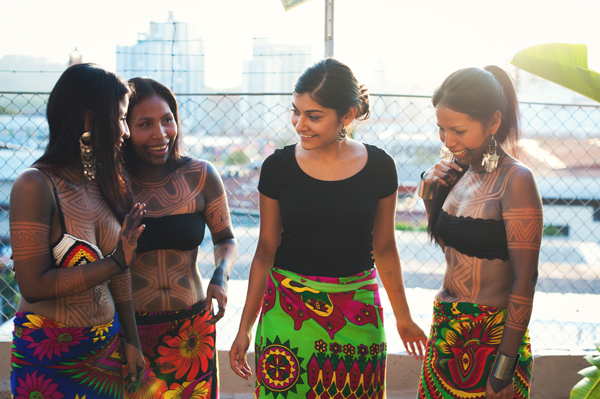Divya Sharma, second from right), in Panama City with three Emberá women wearing traditional body paint, jewellery and parumas / Photo: Alex Tran (http://www.alextranphotography.com/Photography)
This is a great article on the indigenous in Eastern Panama and Alex Tran has some great photography linked at the end.
By Divya Sharma
“This way, over the stream,” calls the young técnico, one of my village guides and GPS experts, as we reach the hill’s peak.
Negotiating thickets of tall grass, puddles of last night’s rainwater and hidden mounds of soil and rock scattered across the rough slope, I pause to catch my breath. Around me are endless fields dotted with fruit trees, grading here and there into dense secondary forests. The tropical sun glares from above, exiling the mosquitoes until dusk, but the técnicos who lead me are undaunted.
We stumble upon hectares of recently burned land. “First we cut the trees and clean the area with machetes, then we burn the land, then we sow,” one of the men explains. “But here, no. Here they’re putting pasture.”
In the indigenous community of Piriatí-Emberá in eastern Panama, conversion of forest to pasture is becoming increasingly commonplace. A four-hour bus ride from Panama City, this community is home to the Emberá, one of the main indigenous groups in Panama. Originally from Colombia, the Emberá practice shifting cultivation and are known for their body painting and the women’s colourful, floral skirts or parumas.
The village consists of one main dirt road. Mostly wooden and some concrete houses, with tin roofs replacing traditional thatched roofs, line the road and branch off to create a community of around 500 people. According to the villagers, interaction with non-indigenous people in schools, in markets and during student visits has contributed to changes in the cultural and biological landscape of the village. My research is aimed at better understanding such changes in the community.
It is due to this concern for the changes that their village has experienced that the villagers participated in a three-day UN-hosted workshop on an integrated development plan for indigenous communities in Panama.
Prior to having begun any data collection, I was given a privileged glimpse into the community’s world as I sat and observed the workshop in the communal house, a large open structure with a tin roof. The workshop began with a Catholic prayer, underlining the intertwined history of the Emberá and outside society.
Throughout the workshop, the speakers, all Emberá, urged their kinspeople to participate in the creation of a shared vision of the future of the village, to take vocal pride in their culture and to fully inform themselves in dealings with the government and others in order to safeguard their knowledge and interests.
As the speeches became more impassioned, the language turned from Spanish to the native Emberá and I was lost. So much for note taking! But suddenly at my side translating with a reassuring smile was Mara, one of the young women to whom I had been introduced my first visit.
During the workshop, five working groups separated by gender and age came up with a list of assets that the community has and then a list of the social, political and economic resources that the villagers would like to have in the future. While the adults spent the day busily debating, conferring and scribbling, the children carried out their own insightful exercise. At the end of the workshop, pictures drawn by some schoolchildren of what they most liked about their community were displayed. The drawings all contained trees and animals as well as electricity, which the village did not yet have.
“What would you do differently if you had electricity in your home?” I had asked one of the women, as she was weaving a wolf mask to sell to one of the visiting students.
“I’d get a dishwasher! And a fridge so I can sell dulces to the kids here,” she had laughed. “Oh, and I’d be able to weave at night.”
As the elder leaders devise a plan for the future, perhaps the children’s outlook sums it up neatly: the future of the community will inevitably entail a fusion of both tradition and development. Sometimes it takes a child to turn on a light.
Divya Sharma is a Master’s student in the Biology Department. Her research is focused on the social-ecological landscape of an indigenous community of eastern Panama under the direction of catherine Potvin. To read more about the lab’s work, go here.
For Alex Tran’s photos go here
